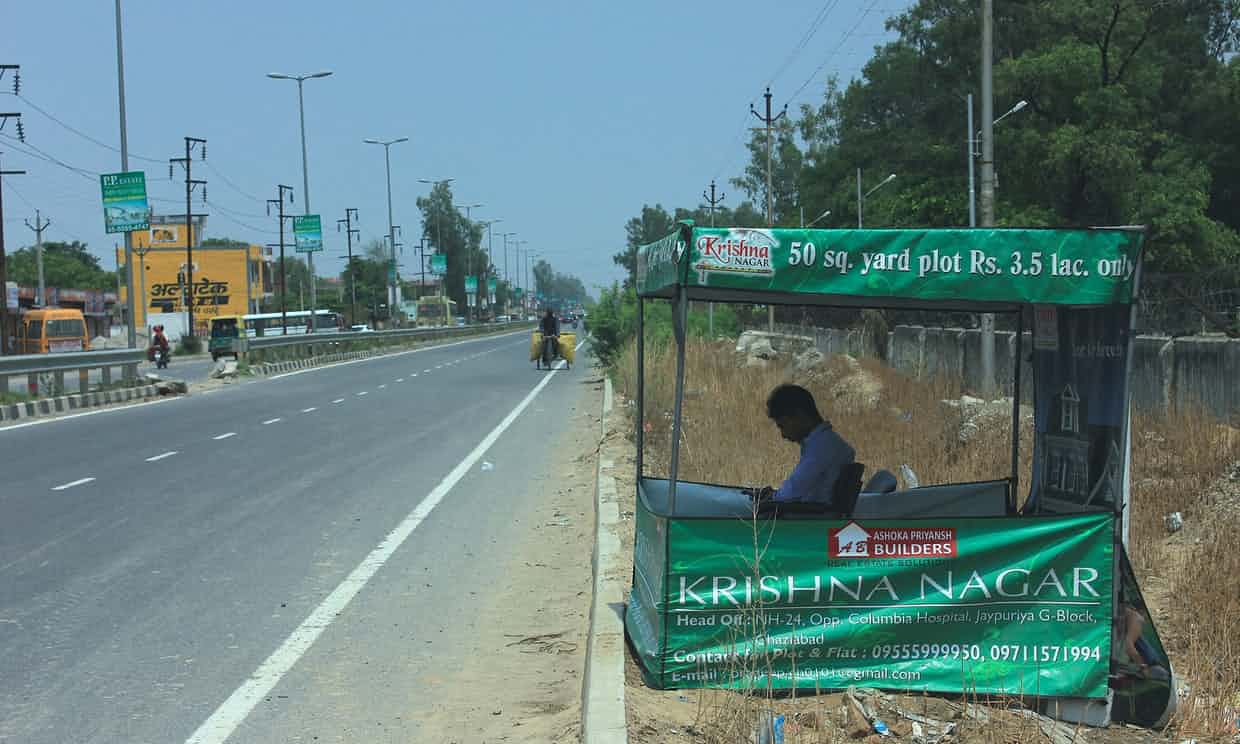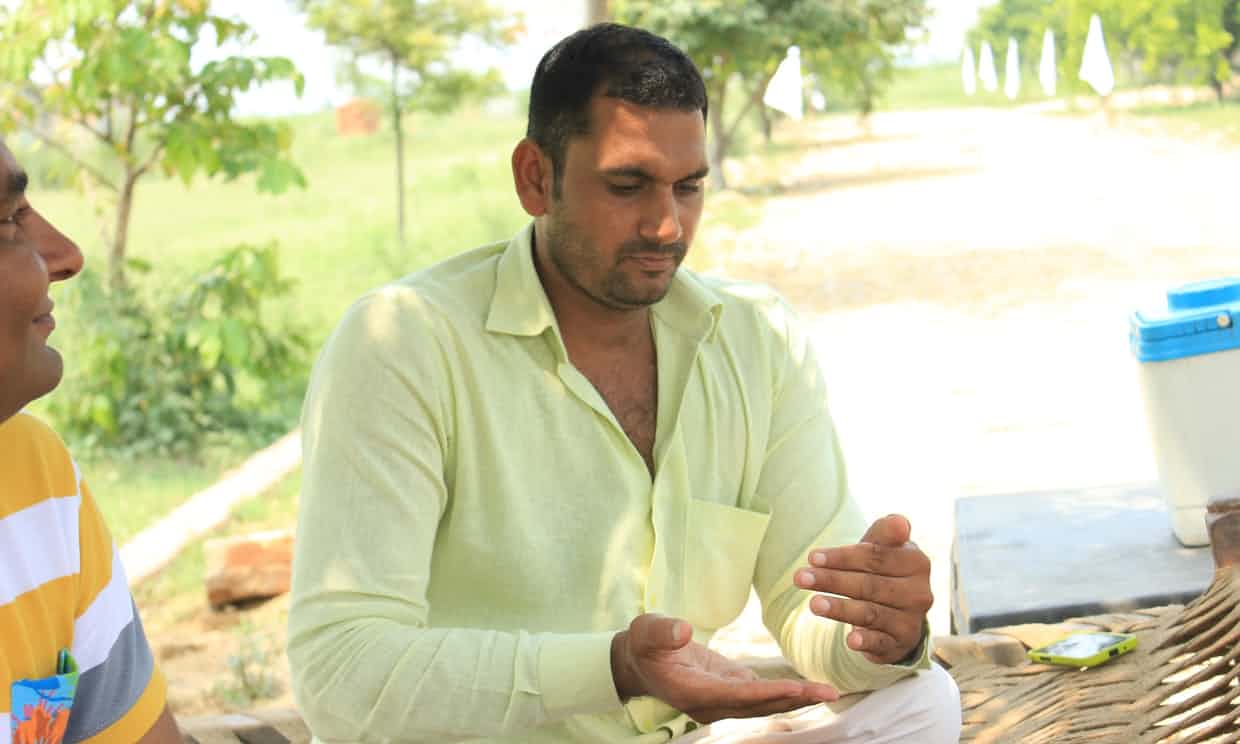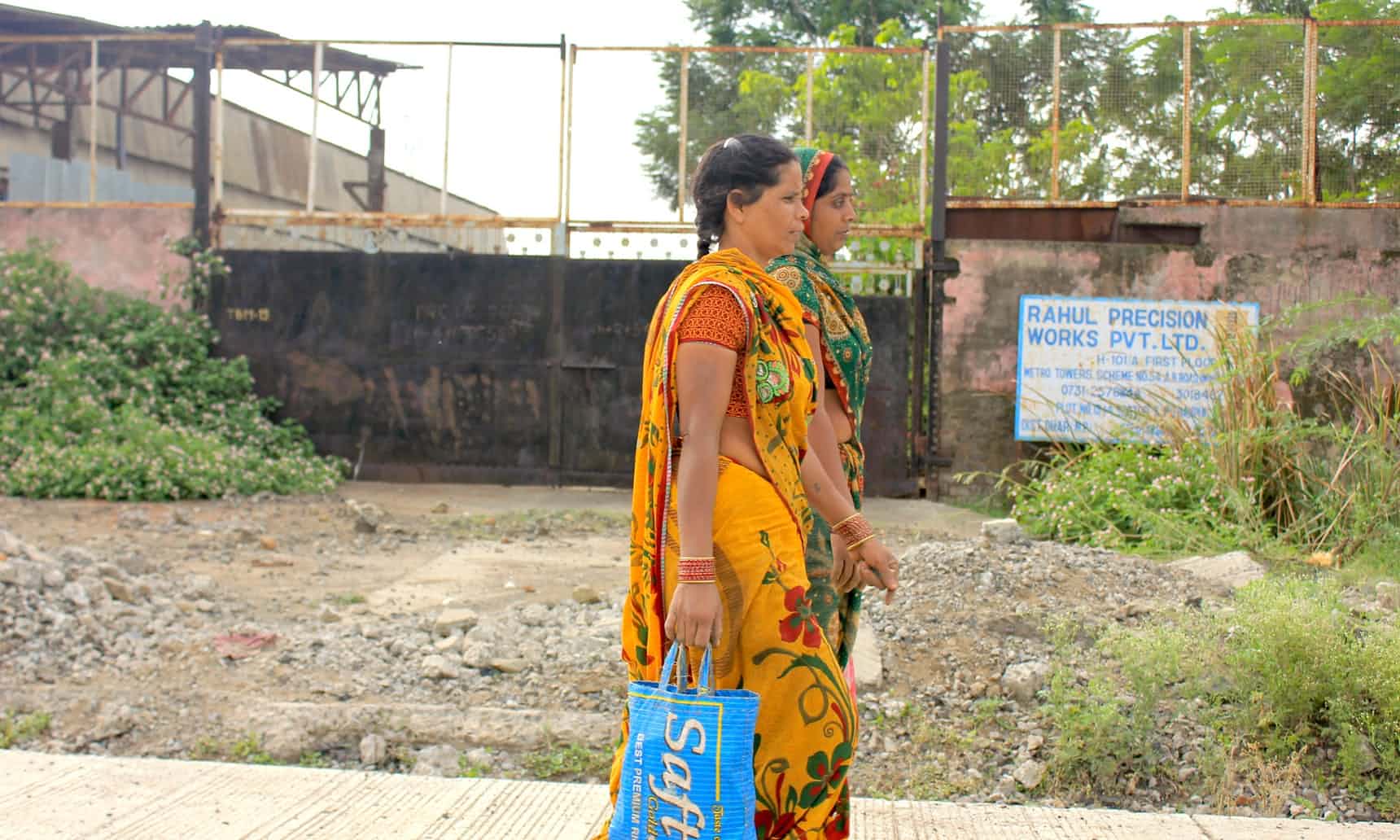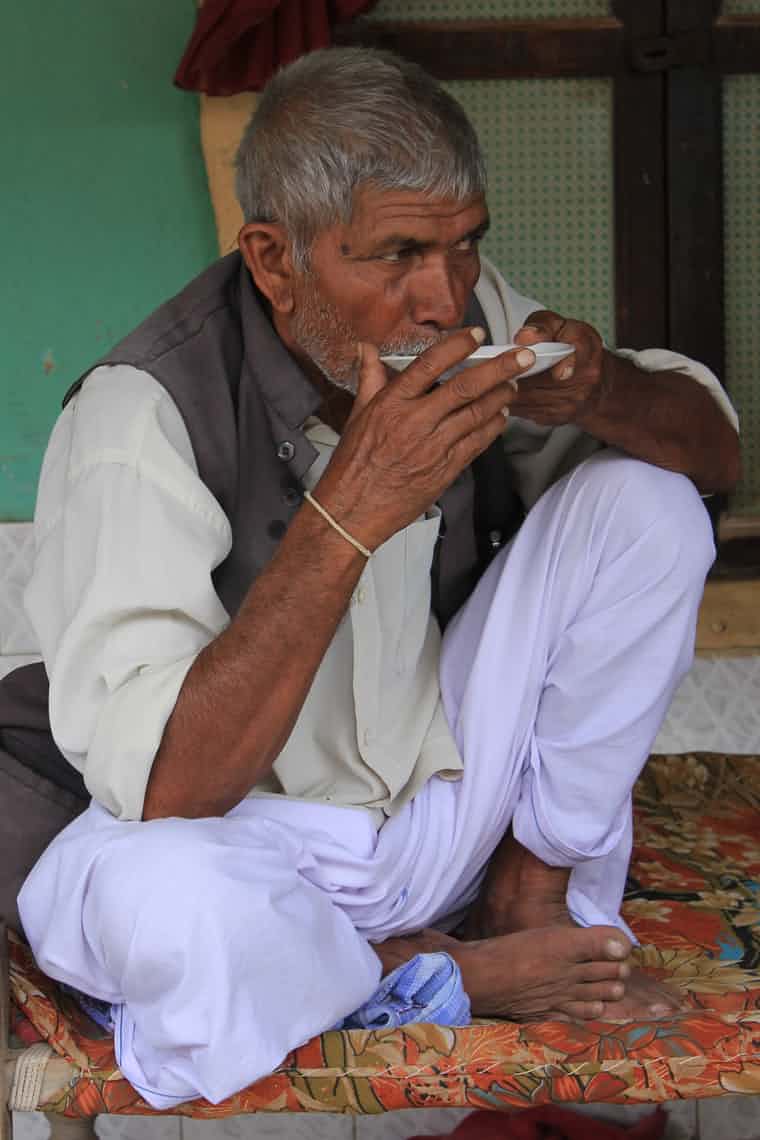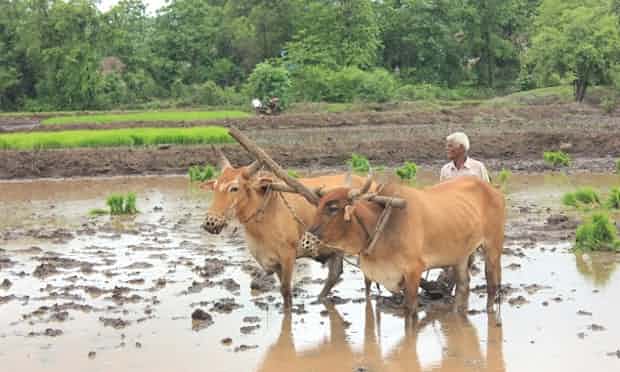The $1bn plan to connect Delhi and Mumbai with a high-speed railway and 24 ‘smart’ cities is touted as the world’s largest infrastructure project. But how do people living on its route feel about the seismic changes being proposed?
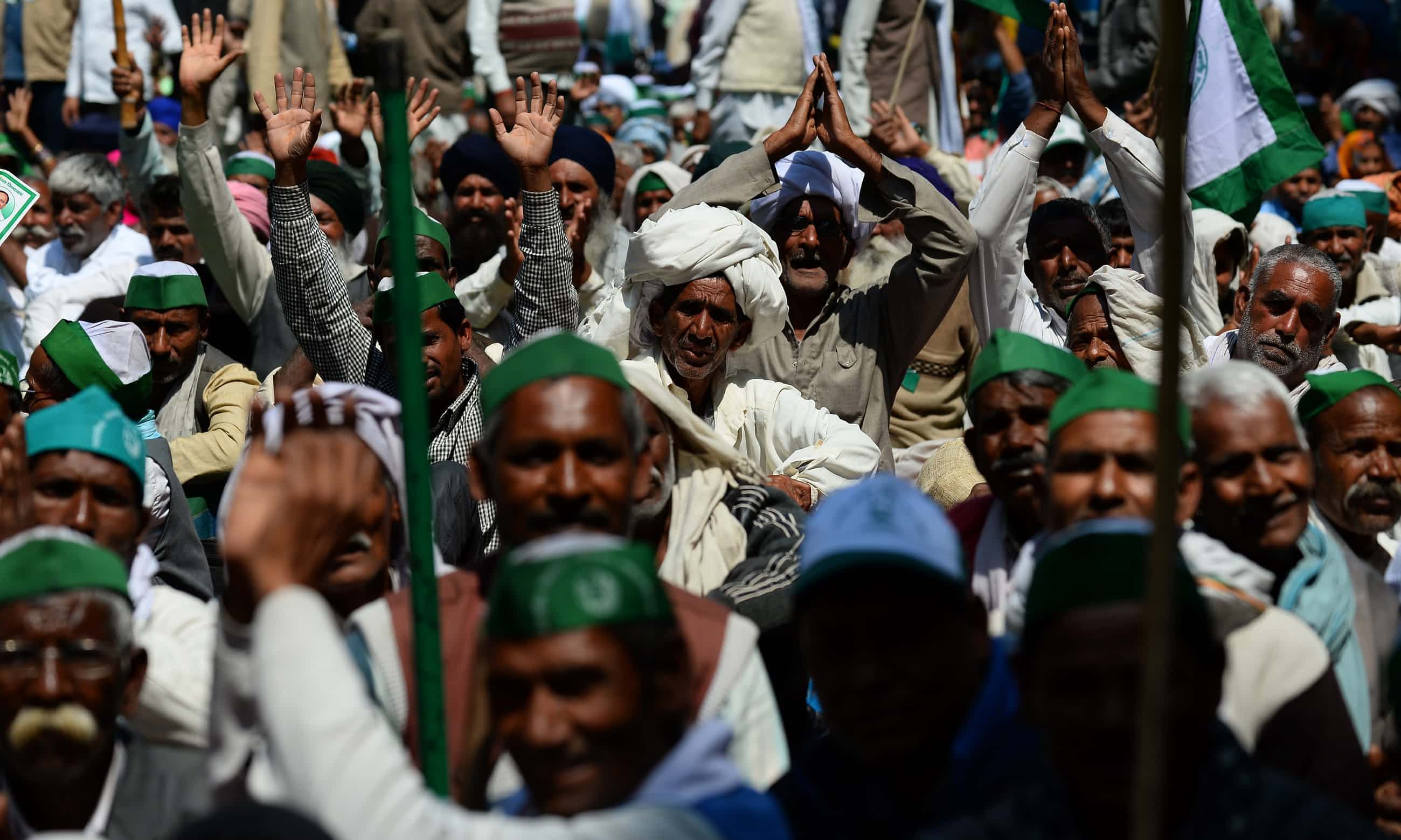
Indian farmers protesting against proposed land reforms in New Delhi. Photograph: Sajjad Hussain/AFP/Getty
One scorching July morning, not far east of Delhi on National Highway 58, my car is waved down by a young boy. Despite the sweat trickling down his brow – evidence of the relentless Indian summer – the smile on his face seems genuine.
Soon two more boys are crowded around the car, competing for my attention. Perplexed at the sight of hawkers on a highway, I strain to see what they are trying to sell me. They thrust blue and red brochures on my windscreen, mouthing something I can’t catch. Lowering the window, I hear a cacophony of voices attempting to sell me a new property:
“We offer a two-bedroom flat for only 22 lakh rupees [£21,500], ma’am!”
“We have better amenities and a brilliant location to boot, ma’am!”
“Ma’am, our company has been building flats for more than 20 years and has a brilliant reputation!”
The scene is reminiscent of vegetable vendors hawking in crowded market places throughout India. The informality with which the boys are selling property worth millions of rupees makes the flats sound like cheap, dispensable goods.
All day long, they sit in tiny, makeshift plastic shelters on the highway pavement, awaiting cars driving down from Delhi. When a car stops after they wave it to a halt (most regular commuters do not), the boys hurriedly put their case forward – plots of land at throwaway prices; yet-to-be-constructed apartments that will fulfil a house owner’s dream. Wanna buy, ma’am?
The exchange is not instant. If a customer shows interest, the boys take their phone numbers and a senior executive from the company gets in touch. According to the boys, they manage to hail down at least seven or eight cars every day. Once stopped, most people apparently give their contact details. I feel that I have glimpsed the undecorated face of India’s urban expansion: desperate, all-consuming, ruthless.
The goliath driving this expansion is the US $1bn Delhi Mumbai Industrial Corridor (DMIC), touted as the world’s largest infrastructure project. While the project was conceived in 2009 by the previous Congress-led government, current prime minister Narendra Modi has made it one of his leadership’s top priorities. The corridor claims it will urbanise 12% of India over the next 30 years.
“When a maelstrom approaches, it uproots even larger trees,” says land-rights activist Sagar Rabari, of the dramatic changes the proposed corridor is expected to inflict on the people and landscape of western India. “What hope can the small shrubs harbour?”
Dadri: land of speculation
I decide to set out and meet some of these “small shrubs”: the people currently living along the proposed Delhi-Mumbai corridor, whose lives may be about to alter radically and irrevocably.
My starting point is the town of Dadri, near Delhi. According to the DMIC proposals, a high-speed railway line, exclusively for freight, will begin here and run south-west for 1,500km across six states, down to India’s largest container port, near Mumbai. Six airports, 23 manufacturing centres, two huge electricity generating units, two ports and a six-lane expressway are also planned, forming the Delhi Mumbai Industrial Corridor. Furthermore, 24 new “smart” cities will be sprinkled along the railway’s route – with each city expected to house anywhere between one and three million people. The timetable is severe: the initial “dedicated freight corridor” has been given a deadline for completion of 2017.
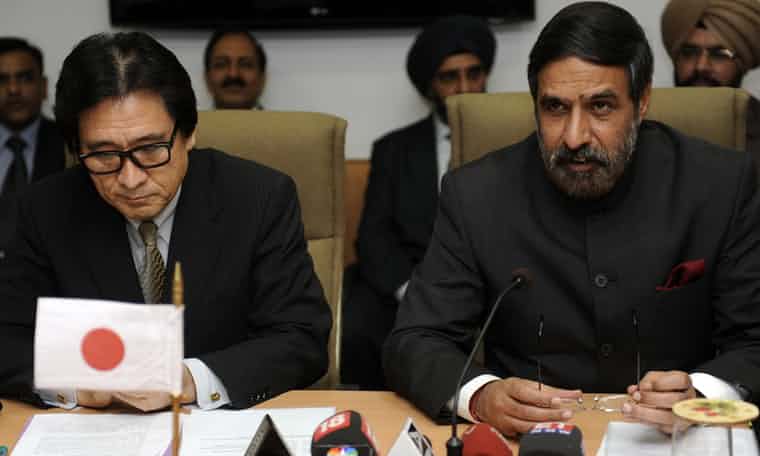
Initial funding for the DMIC has been shared between the governments of India and Japan. Photograph: Manpreet Romana/AFP/Getty
My car positively glides over the smooth, wide roads as I depart the eastern Delhi neighbourhood of Anand Vihar. Yet by the time I reach Dadri, 30km east of the capital, in the unruly neighbouring state of Uttar Pradesh, potholes have taken over the roads completely, highways are lined with large wheat fields, and rural India has officially arrived.
Aside from its busy container depot – which stores and transports huge metallic containers full of agricultural products, steel and spare parts for the automotive industries – Dadri has a laid-back feel. There are traditional seating areas outside the town’s small houses, where people relax with their cups of tea and savouries. Most of its residents are farmers who grow wheat and vegetables.
But the town’s proximity to Delhi guarantees residents that their days of relaxed rural living are numbered. The proposed new industrial corridor is already changing the contours of this region.

Trucks in the container depot at Dadri, starting point for the planned high-speed railway line to Mumbai. Photograph: Raksha Kumar
The premise of the DMIC is that urbanisation is inevitable – based on a 2010 Mckinsey report that predicted 350 million Indians would move to urban centresover the next 30 years. As it stands, most of India’s larger cities are already spilling over and cannot take much more migration. Many were planned a century ago; others were not planned at all, and have grown entirely organically.
DMIC proponents believe building planned cities and manufacturing centres along the corridor will sustain urbanisation for a long time, facilitating the continued growth of the country’s economy. When the plans were announced in this region, however, it opened the gates to land speculators and the controversial prospect of gentrification.
Many of the farmers I meet in Dadri say that spotting land agents in their villages was the first sign their land was suddenly in demand. These agents broker deals between farmers and developers who want to take over the land for non-agricultural purposes. Villagers tell me about the land agents who appear noiselessly in their villages just before a major infrastructure project is announced.
Six years ago, Ashok Mavee heard that a new arterial road was to be constructed through Dadri, his home town. “I thought giving up my land would make me rich, given how much compensation we were being offered,” Mavee says.
Some of his agricultural land was required by the state to construct the new highway; the rest of his land would border it, which didn’t bode well for his crops. Mavee decided to give up all his land in 2009 at the the state’s compensation price of 1.2m rupees (£11,750) per acre. His rain-dependent crops were failing anyway, and he hoped to start a stationery shop in a near by town with the money. Today, the land that Mavee once owned costs six times that sale price, as the arterial highway nears completion.
“When there is connectivity and support infrastructure, land prices will obviously shoot up,” says Rishit Neogi, a Delhi-based land-rights activist. In fact, it seems this dynamic of land-price inflation is underpinning the entire DMIC plan.
“Our aim is to maximise infrastructure development with minimal government funding,” explains Tallen Kumar, CEO of the DMIC Development Corporation. With the existing funding fraction, Kumar says the project will build basic infrastructure such as roads, water pipelines, sewage lines and waste collection. Land prices around this new infrastructure are bound to spike, he continues, at which point that land will be sold at a premium to those who can afford it – with the proceeds being used to construct more of the project.
Perhaps this also explains the desperation with which the young hawkers surrounded my car that scorching July morning. There is a lot of land to be sold to people with cars – and unless it is bought up, this juggernaut of urbanisation could yet stall.
In Dadri today, 12- to 14-storey residential buildings stand on what was once Mavee’s land, with each apartment costing around £19,500. Mavee cannot afford any of them: “I sold the land because I was told the state would force the land away from me in any case,” he tells me.
The Indian government has a legal right to acquire lands for infrastructure projects –although new guidelines for the compensation of former owners are currently being debated in parliament. People have long feared that their land will be taken away by force if they protest.
For his part, Mavee moved to a village 75km from Dadri. “My grandfather owned some land in the town of Greater Noida [close to Delhi], which he sold before moving to Dadri,” Mavee says. “Now, I have sold land in Dadri and have moved further away. I wonder where we are headed next.”
Pithampur: desolate factories
This two-decade-old industrial region, some 900km directly south of Dadri, is my next stop along the corridor. Pithampur is the size of Liverpool, but few people live here; there are no schools and hardly any medical centres.
Instead, Pithampur – in the central Indian state of Madhya Pradesh – is divided into four special economic zones (SEZs). These are commercially driven “islands” within the country, boasting special economic regulations designed to attract foreign investment in specific industries.
Pithampur sits next to the city of Indore, almost as if it couldn’t care less about the thriving metropolis of 1.5 million people on its doorstep. Pithampur has a schedule all its own: every morning around 8am, herds of factory workers in dark blue suits walk with heads bowed, packed lunches in their hands. Their gait is fast and purposeful. Women dressed in sarees hurry to the assembling and packaging units. As the workers enter the factories, Pithampur’s roads go calm again.
Around 2pm, there is another flurry of activity as the work-shift changes. A different herd of workers enters as the first group departs. The process is repeated again when the factories close, at 8pm.
Many of India’s vehicle manufacturing units are located in Pithampur’s sectors I and II; these areas are buzzing at most times of the day. Sector III, however, was meant for small-scale industries – and a drive around this area reveals the corpse-like plight of small-scale manufacturing in India.
I am greeted by the sight of desolate factories standing on weed-infested lands. The roads, water and electricity – pre-requisites for a functioning industry – all seem to exist. Labour is plentiful in the neighbouring villages. So why would these industries have shut up shop in bulk?
I am told that the problems of infrastructure are so acute in certain areas that raw materials don’t reach the industries here on time. There is also not enough water to sustain all this industrialisation – so some smaller industries have found it more profitable to close down.
Pithampur’s Sector III looks like a symbol of failed manufacturing hubs across India – so why is the government ploughing money into a gargantuan industrial project such as the DMIC, rather than concentrating its efforts on existing, struggling industrial areas such as Pithampur?
“I think DMIC is a giant sandcastle, a mirage that we are being shown so land prices can be racked up,” says Babu Singh Patel, 66, a farmer in Kallibillod village, which adjoins Pithampur. “When Pithampur is a failed dream, how can we believe they will build dozens more Pithampurs? We think the DMIC will never happen.”
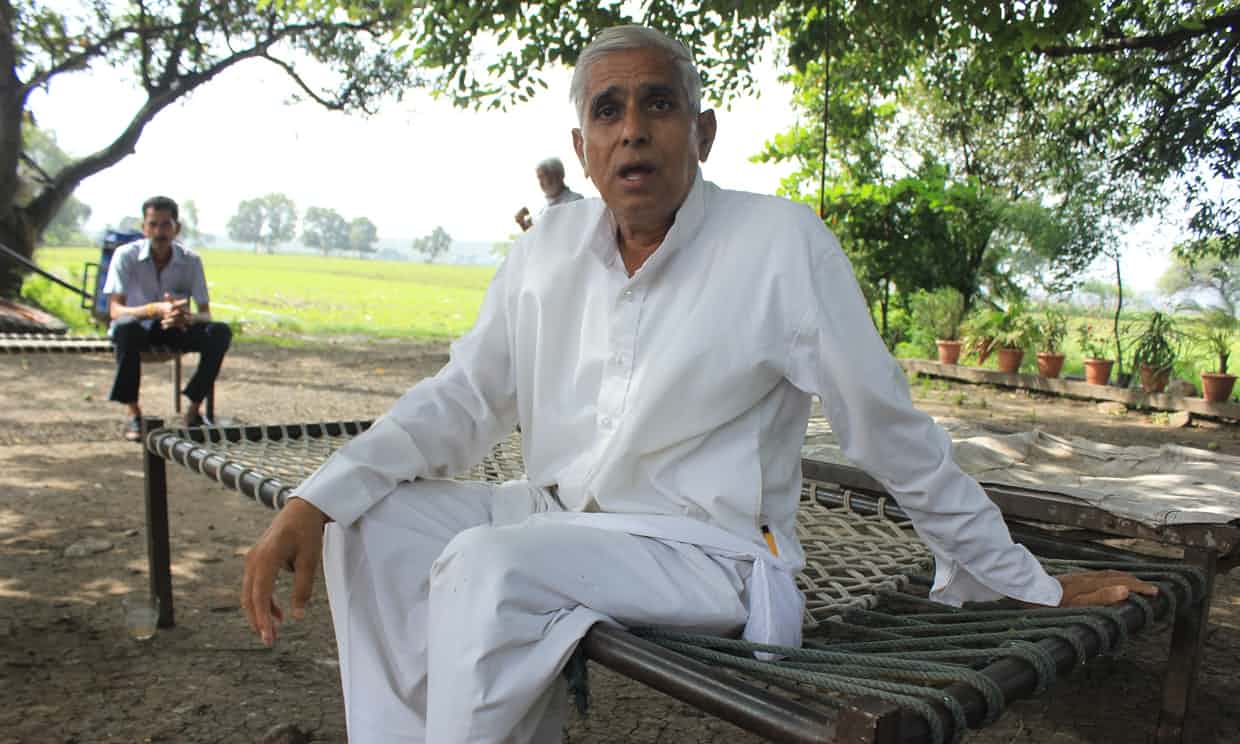
Babu Singh Patel and fellow Pithampur farmers have applied to the High Court to block the government’s plans. Photograph: Raksha Kumar
Patel waves his hands at large tracts of green land behind him, to show me the size of his current plot. If the government has its way, these lands will be acquired for the corridor too. However, Patel and his fellow farmers have filed a case in the High Court to block the government.
It’s not altogether clear how the government’s proposals for the corridor differentiate it from existing manufacturing hubs such as Pithampur. Some who have worked on the plan feel the major difference is its size: the scale and connectivity of the DMIC is unprecedented, and they believe it will make all the difference for previously disconnected industrial areas. “If all the industrial areas are connected and have better infrastructure, the percentage of failed industries would be less,” says Manish Agarwal of PricewaterHouse Coopers in Mumbai.
Tallen Kumar says another major objective of the project is to tackle India’s unemployment levels. In total, the manufacturing hubs along the corridor are predicted to bring employment for about 25 million people – yet this figure seems ambitious, given the rate at which industries are mechanising.
Over the past decade, the number of people employed in Pithampur has gone down at a rate of 10% per annum. “Right in front of our eyes, machines began to replace men,” Patel says.
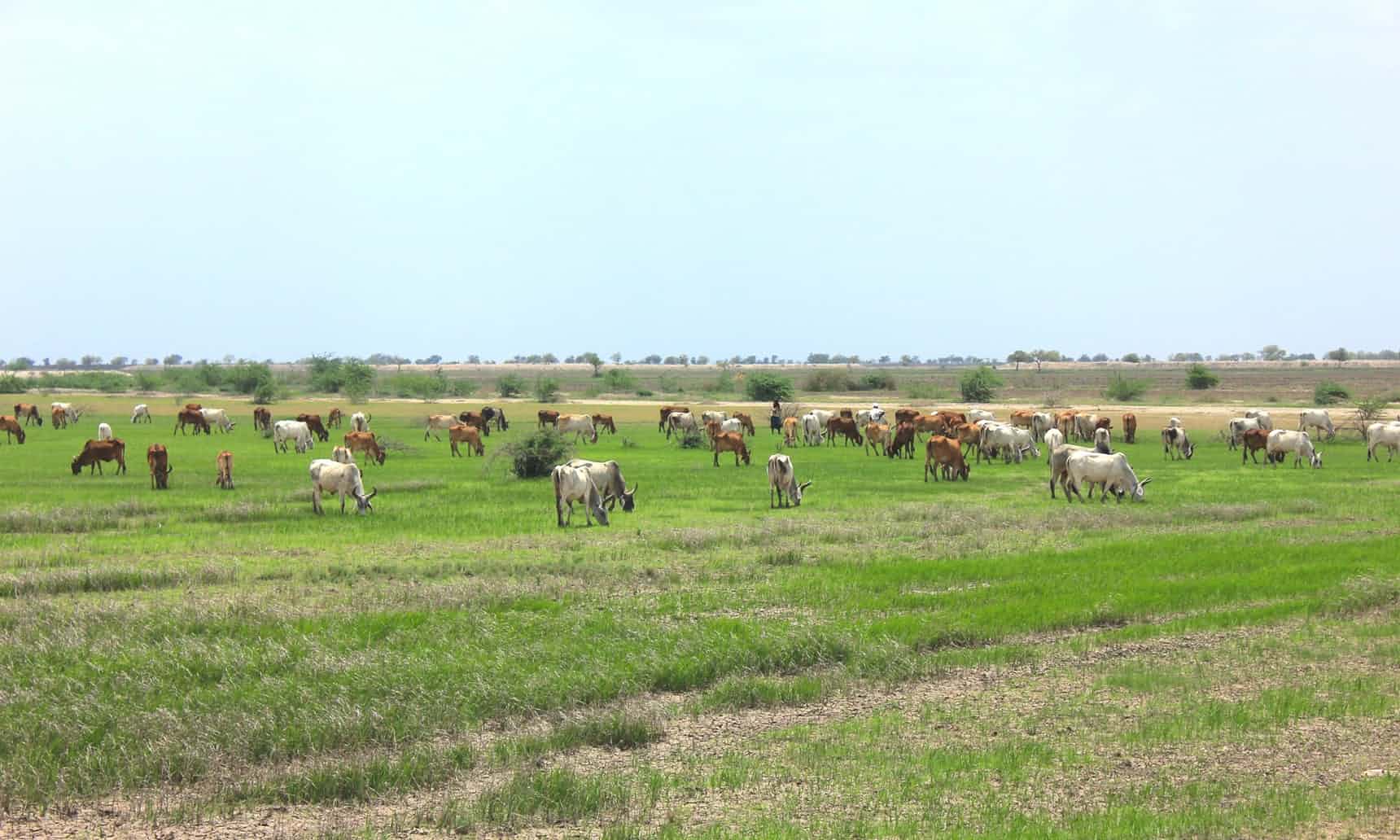
Grazing land for thousands of cattle around the village of Dholera has been notified for industrial use. Photograph: Raksha Kumar
Dholera: tired of dreaming
Roughly 120km south of Gujarat’s largest city, Ahmedabad, a vast expanse of black soil hugs the Arabian Sea. On it rests the small village of Dholera – a cluster of houses with thatched roofs, muddy roads, and acres of flat, fertile land surrounding them.
This region is tired of dreaming – and tired of its dreams being shattered. In March 2009, the Gujarat government announced it was planning to create an industrial region of about 820 sq km – larger than Shanghai – around Dholera. Uprooting around 90,000 people in the process, this industrial region promised to compensate the farmers half in cash, and half by returning 50% of the developed lands to them in due course.
Even as the farmers protested this plan, the land was forcefully acquired. Then, when the DMIC gained steam in 2011, the proposal to erect a separate industrial region was abandoned. Instead, it was announced that the land would now be developed into a large airport and a “smart city”, both part of the fabled new corridor.
The idea of developing a smart city in Dholera that is capable of accommodating the population of New Delhi seems far-fetched, given it is almost equidistant from four other thriving urban centres – Ahmedabad, Rajkot, Vadodara and Bhavnagar.
“Who will come to live here?” asks Sagar Rabari, a local activist. “The four cities that surround Dholera will not suddenly empty out. The plan seems flawed, fundamentally.”
Aparichit Shah (name changed), 23, lives in Bhavnagar, a city that boasts the world’s largest ship-breaking yard. The inheritor of millions of rupees in property and trade, Shah – who will only speak to the Guardian on the condition that he is not named – laughs when he explains how he added significantly to his family corpus by speculating on land in Dholera.
The Shahs bought 15 acres of land here in 2009, when the government first revealed it was setting up an industrial region. A year later, demand for that land had increased as expectations for the area grew. They sold five acres for a handsome profit of 2m rupees (£19,500). “It was in 2010 that the rumours began of an international airport being constructed in Dholera,” Shah says.
The following year, when the DMIC was announced in Dholera, the Shahs sold a further five acres of land, making three times the amount they had invested just two years earlier. The Shahs have close links to local politicians, who alert them of impending infrastructure plans.
Close to 20,000 farmers are opposing the plans for the Dholera industrial region and smart city. Hanubhai Jadav, 62, was one of the 56 farmers who surrounded the authorities when they arrived in large open-air jeeps to talk to the residents about land acquisition. “We told them we do not want their compensation,” Jadav says. “We want our land, and we want to eat what we till.”
About a hundred yards behind his mud house is a plot of land the size of a small children’s play area. Jadav grows papaya, bamboo, sugarcane, egg plant, tomatoes and curry leaves there: “We are at least self-sufficient now. If this land is taken away, what will we eat?”
Farmers in about four villages in the region feel they have been taken for a ride. The authorities have changed their minds on what infrastructure project should come up in Dholera at least three times in the past six years – from the industrial area to an airport to a smart city. “I think they have made up their minds it could be anything but agriculture,” Jadav concludes.
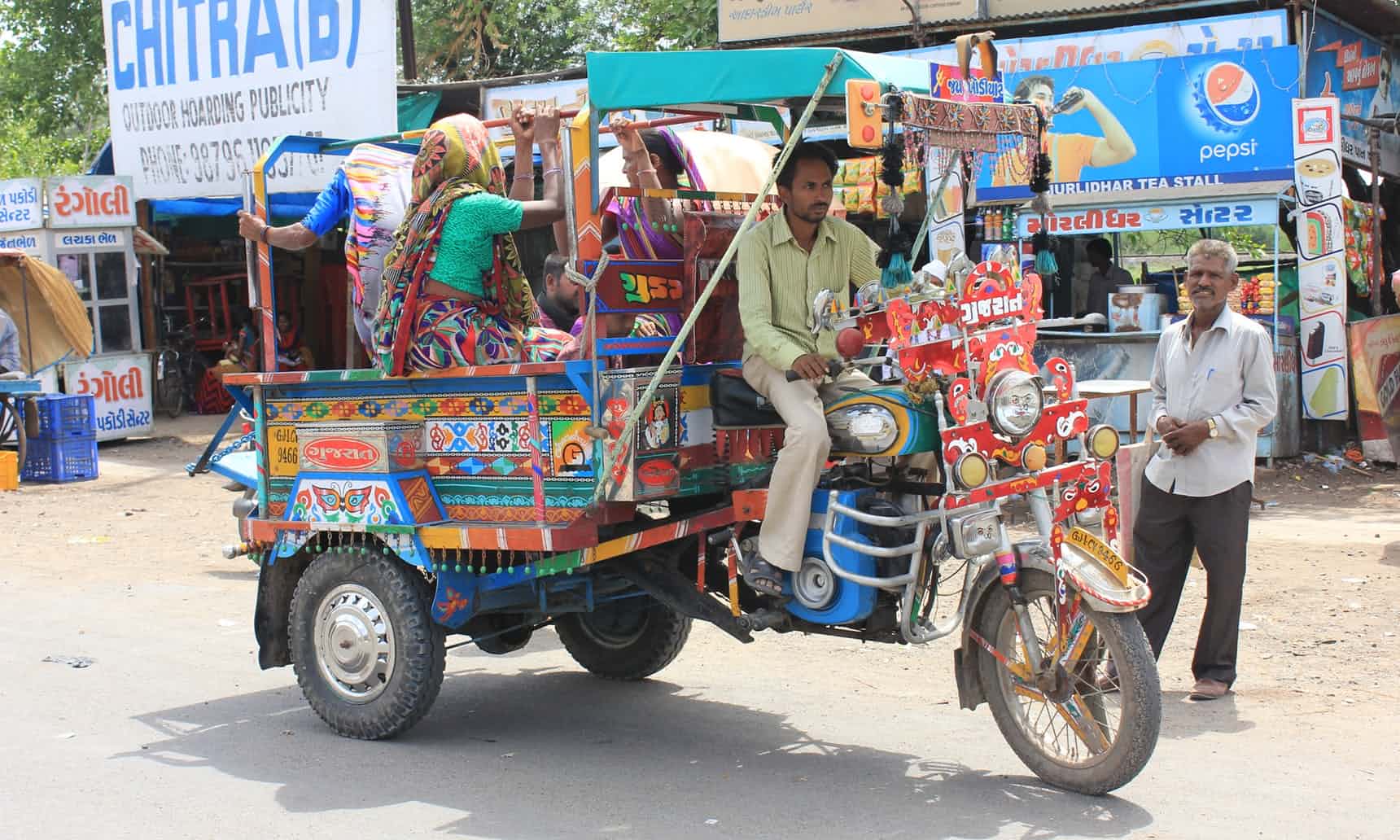
A common mode of transport in Dholera, the planned site of a new ‘smart’ city and airport. Photograph: Raksha Kumar
Mangaon: fertile protests
The corridor is due to end at the Jawaharlal Nehru Port, 200km south of India’s commercial capital, Mumbai. Driving south-east from the megacity’s centre to the suburb of Panvel, skyscrapers make way for silky flyovers and smoother roads. You could break your neck trying to look up at all the giant residential apartment buildings along the way.
Then, as suddenly as a change of theatre backdrop, the landscape transforms after Panvel. Green-covered hills and rain-soaked rice fields announce the advent of the Konkan region, the green coastal belt of south-western India. Now a winding, single-lane road leads all of the trucks, state transport buses, cars and occasional motorbikes through the village of Mangaon. The Jawaharlal Nehru port is about 70km from here; every inch of farmland in Mangaon has been notified by the government, and will be acquired for the corridor in due course.
Several farmers in Mangaon are university educated; they say their proximity to the major urban centres of Mumbai and Pune ensured that they received a quality education. They are also familiar with the urban way of life:
“It is too fast and too stressful,” says 60-year-old Abhay Narayan Rao, who looks after 25 acres of land while his sons work in multinational corporations in Mumbai. “Doesn’t our desire to stay on in the village and pursue agriculture mean anything?” asks Rao. “Why are our fertile farm lands being taken away?”
Rao’s older son wants to return to the village and involve himself in agriculture – which is not such a surprise here. Several young professionals who studied and worked in larger cities have returned to Mangaon for a more peaceful way of life.
According to the central government, more than 45% of the Indian population relies on agriculture, which contributes only 12% of the nation’s GDP. The industrial corridors are an attempt to shift that imbalance – but predictably, the farmers here are unimpressed.
Rabbari says there are smaller changes one can make to strengthen agriculture, instead of investing billions of dollars on industrial corridors. For instance, Mangaon grows a slew of vegetables and fruits along with the main crop, rice. But the single-lane road connecting this village to Mumbai makes the travel time a tedious five hours. Instead of acquiring all the farmland in this village, the farmers are demanding the road be expanded into a four-lane highway.
“If our produce can reach Mumbai in 2.5 hours, the demand for our crops will quadruple,” says Rao. Mumbai is a large urban market where the demand for organic produce is very high.
“We do not believe that urbanisation is inevitable,” says Rao. He loves to live in his 200-year-old ancestral home, which has 37 rooms and a large step-well right behind it. Sitting on his stony porch, Rao asserts that he is not being romantic about the benefits of agriculture:
“Here we earn more than 120,000 rupees [£1,170] a year, and our cost of living is one-fifth that of a city’s. Why would we give this up and move to a place that would fetch us less, and suck more out of us?”
The DMIC is not only the pioneer, but also an experimental ground for at least four more industrial corridors that are proposed across India. The government says it wants as many as 18 such corridors to criss-cross the country in the future. Masterplans for the eastern and southern corridors have already been approved – but given the red flags being raised by people who reside between Delhi and Mumbai , it seems unlikely they will follow seamlessly.
With sweat dripping down his tanned forehead, Hanubhai Jadav of Dholera stands in front of a small temple in his village and tells me that, if he could get the local politician to back off from acquiring his prized Apiece of land, he can do it with anyone. Jadav’s determined face betrays no doubt: “We shall overcome,” he adds with a smile.
The same, stifling July heat does not reach the swanky air-conditioned rooms where the advocates and executors of India’s new industrial corridors are based. “We are confident the government will find a way to acquire land for this project,” says Tallen Kumar, of the DMIC Development Corporation. His face looks as confident as Jadav’s – but the quaver in his voice might just have betrayed some deeply harboured doubts.
Published in: The Guardian
Published on: 15 September 2015
Link: https://www.theguardian.com/cities/2015/sep/15/indias-future-dmic-delhi-mumbai-industrial-corridor


